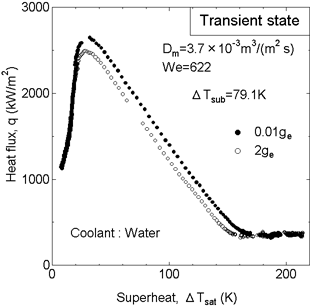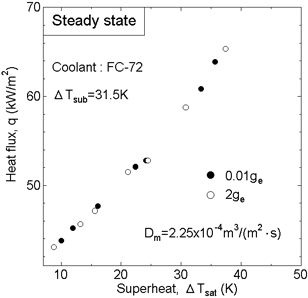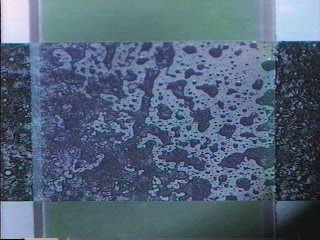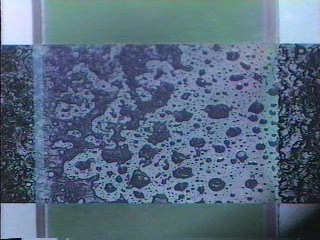|

Fig. 9 Spray Cooling Characteristics for Water at a High Volume Flux
When the spray volume flux is sufficiently high, droplets having impinged
on the heater surface coalesce each other and form liquid films covering
a significant proportion of the surface even in a superheat range close
to the CHF point. Because of the dimensions of those liquid films far exceeding
those of impinging droplets, the configurations and behavior of the films
are presumably under the influence of gravity. If this is the case, the
heat transfer in a liquid-film-dominating region including the CHF point
should inevitably be dependent on gravity.
In the film boiling region, droplets sprayed onto the heater surface
split into tiny fragments instead of coalescing each other. (Note that
We > 600 in the experiments of the present concern.) Those fragments
- disintegrated droplets - presumably evaporate away in the vicinity of
the heater surface irrespective of the level of gravity. Consequently gravity
effect is vanishing in the film boiling region.
FC-72 (Reduced and Elevated Gravity/Low Spray Volume Flux)
Figure 10 shows the heat transfer characteristics observed with FC-72
sprayed onto the glass-prism heater under reduced and elevated gravity
conditions. The range of the experiments is limited to the nuclear boiling
region below the CHF point. Here we hardly recognize any gravity effect
on the heat transfer. Figure 11 shows two rear-side views of the heater
surface upon which a heat flux close to the CHF was imposed - one obtained
under the reduced gravity and the other under the elevated gravity. Again
we find little difference between these views. It seems that droplets having
impinged on the heater surface immediately evaporate, rarely causing mutual
interaction and thereby experiencing little gravity effect.
|
|

Fig. 10 Spray Cooling Characteristics for FC-72 at a Low Volume Flux- Low
Superheat Range

0.01 ge (q = 63.9 kW/m2)

2 ge (q = 65.3 kW/m2)
Fig. 11 Observations of Heater Surface in FC-72 Spraying (Dm
= 2.25×10-4 m3/(m2.s) )
|